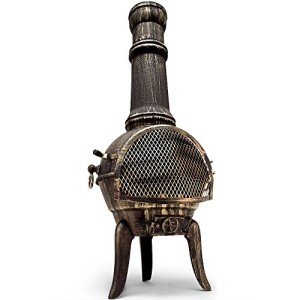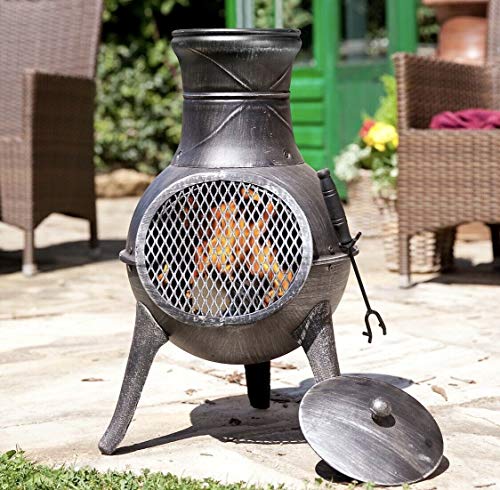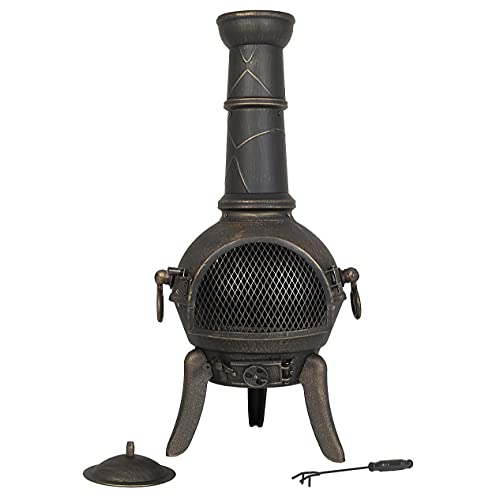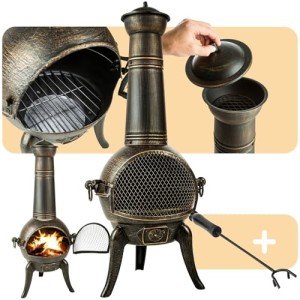The idea of gathering around a warm, inviting fire on a chilly night is a time-honored tradition. For homeowners looking to enhance their outdoor space, a large outdoor cast iron chiminea patio heater serves as an attractive and functional solution. This guide delves into the various aspects of a cast iron chiminea, including its benefits, maintenance, and usage tips, along with frequently asked questions.
What is a Cast Iron Chiminea?
A chiminea is a traditional outdoor fireplace made from clay, cast iron, or other materials. The large outdoor cast iron versions are particularly favored for their sturdy construction and aesthetic appeal. They are designed to radiate heat efficiently and provide a cozy atmosphere for outdoor gatherings.
Table 1: Key Features of a Cast Iron Chiminea
| Feature | Description |
|---|---|
| Material | Heavy-duty cast iron, known for its durability |
| Heat Retention | Excellent heat retention properties |
| Design | Often includes intricate designs and patterns |
| Size | Available in various sizes; the large versions typically exceed 50 inches in height and width |
| Versatility | Can be used for wood, charcoal, or even gas |
Benefits of Having a Cast Iron Chiminea
Investing in a large outdoor cast iron chiminea offers numerous benefits:
- Heat Efficiency: Cast iron is excellent at conducting heat, allowing for an even and prolonged warming experience.
- Durability: Unlike clay or metal alternatives, cast iron is resistant to weather and will last for many years with proper care.
- Aesthetic Appeal: With their rustic and traditional designs, cast iron chimineas can serve as a stunning focal point in any outdoor area.
- Versatility: They can be used for heating or cooking, making them a multifunctional addition to your patio.
- Environmentally Friendly: Burning wood offers a clean-burning flame, especially when using dried wood, making it an eco-friendly heating option.
Table 2: Comparison of Chiminea Materials
| Material | Heat Retention | Durability | Maintenance |
|---|---|---|---|
| Cast Iron | Excellent | High | Moderate |
| Clay | Moderate | Moderate | High |
| Steel | Moderate | Low | Low |
Choosing the Right Cast Iron Chiminea
When selecting a large outdoor cast iron chiminea, several factors should be considered:
- Size and Weight: Consider the space you have available. Ensure the chiminea fits well within your patio or backyard without being overwhelming.
- Design: Look for designs that match your personal taste and the overall aesthetic of your outdoor space.
- Top Quality: Opt for brands that are well-reviewed to ensure you're purchasing a product that will stand the test of time.
- Ventilation: Ensure that it has adequate air flow for efficient combustion and heat production.
Maintenance Tips for Your Cast Iron Chiminea
Proper upkeep of a cast iron chiminea is vital to prolong its life and maintain optimal function. Here are some maintenance tips to keep in mind:
- Regular Cleaning: Clean out ash and debris after each use to prevent rust and prolong its lifespan.
- Seasonal Care: During off-seasons, consider covering your chiminea to protect it from the elements.
- Rust Prevention: Occasionally apply a high-temperature paint designed for cast iron to prevent rusting.
- Check Your Firewood: Use properly seasoned hardwood for an efficient burn and minimal residue buildup.
- Inspect: Regularly inspect for cracks or damage, which can be detrimental to its performance and safety.
Table 3: Maintenance Checklist
| Task | Frequency |
|---|---|
| Clean ash and debris | After each use |
| Clean exterior | Monthly |
| Inspect for cracks | Monthly |
| Apply rust prevention coating | Annually |
| Cover during off-season | Seasonally |
FAQs About Large Outdoor Cast Iron Chimineas
Q1: How do I light the fire in my chiminea?
A: Start with crumpled paper or fire starters at the bottom, add small kindling on top, and then place larger logs once the kindling catches fire. Ensure proper ventilation.
Q2: Can I use my chiminea for cooking?
A: Yes, many chimineas are designed for cooking purposes. It's recommended to use grilling grates specifically designed for use with chimineas.
Q3: What type of wood is best for my chiminea?
A: Choose seasoned hardwoods like oak, maple, or birch. Avoid softwoods like pine, as they produce more creosote and can be less efficient.
Q4: How do I store my chiminea during winter?
A: If plans permit, store it indoors or cover it with a waterproof cover outdoors to protect it from snow and moisture.
Q5: Can a chiminea be used in a covered patio?
A: It is advised to avoid using a chiminea in enclosed spaces due to the risk of carbon monoxide buildup. Always ensure adequate ventilation.
A large outdoor cast iron chiminea patio heater is more than just a heating device; it is a centerpiece that brings functionality and charm to outdoor spaces. By understanding its features, benefits, and proper maintenance, homeowners can enjoy years of cozy nights spent under the stars with family and friends. Whether you’re roasting marshmallows or simply soaking in the warm glow, a chiminea is a wonderful addition to any backyard oasis.






